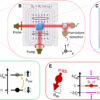A team led by scientists and engineers from the University of Wisconsin-Madison, the University of Southern California and Washington University in St. Louis, has created a unique, record-setting material that can bend one infrared ray of light in two directions.
For the second time in five years, the team created a crystal with the highest degree of what’s known as “double refraction” on earth. This time they beat their own record, and the new higher-performing crystal could lead to innovations in night vision, Lidar, chemical sensing, microscopy, and many other applications.
The work was published by the journal Advanced Materials. The UW-Madison leads are Hongyan Mei, an electrical and computer engineering Ph.D. student, and Jad Salman, a 2022 Ph.D. graduate, both from the group of Mikhail Kats, associate professor of electrical and computer engineering.
When light travels from one substance to another—for instance, from air into water, or water into glass—it slows down by a predictable amount, and that causes the light to bend. This bending is called refraction.
Double refraction happens when that ray of light enters an anisotropic material—one with properties that are different depending on direction—and splits into two rays, each headed different ways. Imagine a bundle of rods grouped together, with one refractive index, or measure of its bending ability, down its length, and another in the perpendicular direction. The difference between those two refractive indices is called birefringence.
Despite the team’s previous experience with record-setting birefringence, Kats and his group were surprised to discover that the birefringence in the new material, called strontium titanium sulfide (Sr9/8TiS3 or STS), is 3 times the birefringence of their previous record-holder, barium titanium sulfide (BaTiS3 or BTS), which should have had a similar structure.
Why, exactly, was a mystery. After an atomic-level examination of the strontium titanium sulfide, grown by Ph.D. student and co-lead author Boyang Zhao and colleagues at USC, the team found that it had a few more strontium atoms than expected. Those extra handful of atoms made the difference: They caused the crystal to have a much larger repeating structure, or periodicity rather than a single, unchanging crystalline structure.
Colleagues at Washington University in St. Louis, including Ph.D. student and co-lead author Guodong Ren, examined this arrangement, coming up with atomic-scale theories for the huge optical anisotropy.
“It turns out that when you have this particular crystal arrangement, the structure results in an enhanced refractive index along one direction of the material,” says Kats. “This was very, very unexpected. You generally don’t expect such a small atomic-scale change to result in such a large difference in optical properties.”
Mei says the finding is significant. “This degree of anisotropy is as large as it’s ever been measured in any optical material.”
The observation that tiny changes in atomic structure can lead to huge changes in the optical properties of a material may have other consequences too. “We might be able to find similar materials where a small external stimulus—whether that’s bending, heating or passing a current through it—can dynamically change the optical response,” says Kats. “A whole new class of optics applications becomes possible if you have a material that’s tunable with such a big change in refractive index with the press of a button.”
Currently, the synthesis method only creates small flakes of strontium titanium sulfide. With some refinement by colleagues at USC, it may be possible to create large, single-crystal versions of the material for use in modern optical technologies.
And now that the unique structure of the crystal is known, it is also possible to search for other crystals with similar or even stronger optical properties. “There is a whole family of materials of this type that seems to be hiding all sorts of secrets,” says Kats. “We are excited about what we’ll find when we dig further into this class of materials.”
More information:
Hongyan Mei et al, Colossal Optical Anisotropy from Atomic‐Scale Modulations, Advanced Materials (2023). DOI: 10.1002/adma.202303588
Provided by
University of Wisconsin-Madison
Citation:
Curving light in a record-setting way (2023, September 27)



